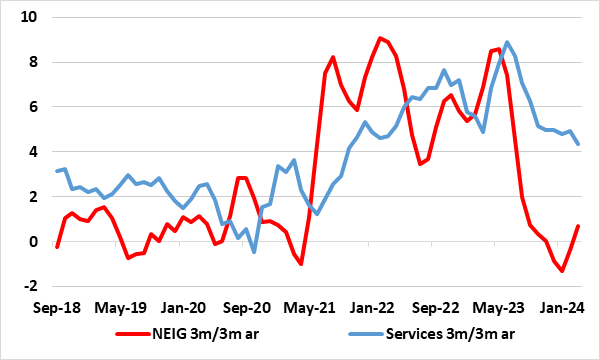UK: Services Inflation Resilience – An Alternative Perspective?
Although still with three members openly resistant to cutting Bank Rate, it does seem as if an MPC majority is nevertheless edging toward easing policy conventionally. This reflects a view among the less hawkish and more pliable MPC members that risks to persistence in domestic inflation pressures are receding. We would agree that there are such signs but would also argue that some of the hitherto worries about price resilience, most notably with services, has been overdone. Indeed, while what we regard to be underlying services inflation is still well above that for core goods, this is nothing unusual (Figure 1). More notably, the recent fall in overall services inflation has been at a pace very similar to the previous surge, hardly an indication of more recent price resilience. Indeed, the pace of the recent fall is actually much greater when looked at using more short-term dynamics (Figure 2). BoE rate cutting is very much on the immediate policy agenda and on a protracted basis, with Governor Bailey underscoring recently that all MPC meetings from here on are ‘live’!
Figure 1: Services Inflation Historically More Persistent than for Goods

Source; ONS, % chg y/y
Services Inflation in Perspective
It is clear that an economic and ensuing policy reassessment is occurring within large parts of the BoE. A recent speech by Deputy Governor Ramsden highlighted that consideration such as inflation expectations and wages, suggest that the restrictive stance of policy and the more symmetric unwinding of second round effects are also reducing the more persistent components of inflation such as services inflation. As a result, he now says that the balance of domestic risks to the outlook for UK inflation is now tilted to the downside compared to the MPC’s February 2024 forecasts that inflation stays close to the 2% target over the whole forecast period.
Fundamental to this is a reassessment of services inflation, currently still at 6.0% in y/y terms. From the BoE perspective, services inflation are a better indication of persistence than goods as they more reflected domestic inflationary pressures, in large part from the labour market, and that these pressures are inherently more slow moving or stickier, particularly when labour markets are tight as seemingly has been the case in the UK of late. And against an emerging backdrop of softening pay pressures and energy prices (energy prices to be more important in driving services), it is understandable how worries about price resilience, particularly for services have diminished, at least for what appears to be a majority of the nine-string MPC
Figure 2: Services Inflation Drop Gathering Momentum

Source; ONS, ar=annualized adjusted rate
Recent Actual Price Dynamics
It is hard to argue against such logic. However, it glosses over the fact that there has been little clear evidence of services inflation having been seemingly resilience of late. Admittedly, overall headline services inflation is running at almost twice the headline rate. This though is nothing unusual with the ‘lowinflation’ decade prior to the pandemic having seen services run at 2-3 times that for core goods (Figure 1). Moreover, while the current 6.0% y/y services rate has fallen only 1.4 ppt from the 7.4% peak set last May, having risen from a low of around 1% in 2020 (amid many distortion), the rate of fall at around 0.2 ppt per month is actually virtually the same as the pace at which it rose.
Figure 3: Current Fall in Services Inflation Faster than the Surge

Source; ONS
Especially as this current 6.0% rate still includes some 4 ppt of adverse base effects (which should unwind of the next 3-4 months), this is hardly an indication of more recent price resilience. Indeed, while not matching the slump in non-energy industrial goods inflation, the pace of the recent fall is actually much greater when looked at more short-term dynamics (Figure 2) which exclude those marked and adverse base effects. Indeed, using a 3-month annualized seasonally adjusted rate (ie a measure that the BoE seems to be embracing increasingly of late), services inflation is now running at just over 4%, having halved in the last year, encompassing an average m/m drop of 0.5 ppt, over twice the rate at which services rose to that May 2023 peak (Figure 3).
Policy Outlook
Admittedly, there are some signs in these more short-run measures that the disinflation process may have halted, even partly reversed. To what extent this reflects recent distortions, accentuated by the early Easter and unseasonable weather is unclear – we will monitor continually. Bu the extent to which inflation has eased and will come down further in coming month does seem to be making the BoE think that inflation will not only hit if not undershoot target in coming months but stay there. This is likely to be evident in updated projections the BoE will produce for the May 9 MPC meeting and which may see the vote in favor of immediate easing rise from the one dissent seen in March. Thus should pave the way for a majority in favor in time for the June MPC meeting by when the April CPI data (due May 22) may have dissipated any lingering worries about price resilience!